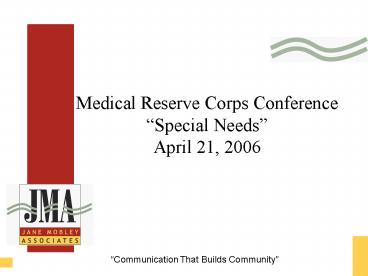Medical Reserve Corps Conference - PowerPoint PPT Presentation
1 / 16
Title:
Medical Reserve Corps Conference
Description:
Public serving agencies are expected to do more every year, yet their annual ... Pacific Islanders/Aleuts/Eskimos. Illegal/undocumented immigrants. Refugees ... – PowerPoint PPT presentation
Number of Views:31
Avg rating:3.0/5.0
Title: Medical Reserve Corps Conference
1
Medical Reserve Corps ConferenceSpecial
NeedsApril 21, 2006
Communication That Builds Community
2
Special Needs
- Vulnerable populations
- Hard-to-Reach populations
- Special needs populations
- At-Risk populations
- Culturally Diverse Groups
3
Outside the Mainstream
- Katrina shone a hard light on a national weakness
- our capacity to be realistic about how many
people living in America are outside the
communication mainstream.
4
- How do we communicate with diverse populations
about emergency preparedness or response?
5
Doing More With Less
- Public serving agencies are expected to do more
every year, yet their annual resources reflect
fewer dollars and people. Adding outreach to
special populations to a communications to do
list seems impossible.
6
Medical Reserve Corps Units
- Improve health literacy by
- Increasing disease prevention
- Eliminating health disparities
- Improving public health preparedness
7
Dr. Richard H. Carmonas priorities state
- All Americans - regardless of their race,
heritage, or gender - should have access to good
health information, insurance, and services. MRC
units may wish to target areas within their
jurisdiction that may traditionally be
underserved.
8
Targeting Underserved Populations
- Define
- Locate
- Reach
- There are resources in your community that can
help you understand and motivate diverse
populations. Utilizing them effectively requires
collaboration.
9
Who are the Underserved?
- Low Income groups
- Medicaid recipients
- Working poor
- Living at or under the poverty line
- Those dependent on public transportation
- Non-English speaking
- African
- Hispanic/Latino
- Asian
- French
- Middle Easterners
- Pacific Islanders/Aleuts/Eskimos
- Illegal/undocumented immigrants
- Refugees
- Blind and visually impaired
- Chronically ill
- Deaf and hard of hearing
- Developmentally disabled
- Drug and/or alcohol dependent
- Mentally ill
- Brain disorders/injuries
- Mobility impaired
- Energy dependent
10
Who are the Underserved cont.
- Frail elderly
- Pregnant women
- Mothers with newborns
- School-age, latchkey children
- Juvenile offenders
- Families with children with healthcare needs
- Homeless
- Homebound elderly
- Remote rural
- Dense urban populations
- Seasonal migrant workers
- People displaced by disaster
11
Comprehensive Identifiers
- Economically disadvantaged
- Limited language competence (non-English
speaking, low literacy, undocumented) - Disabled (physical, mental, sensory, cognitive)
- Age vulnerable (very old, very young)
- Geographically/culturally isolated (remote rural,
deep urban)
12
Community Engagement
- Build a network of trusted individuals
representing different population groups - Seek out often untitled leaders as well as
officials - Exercise the network in non-emergency
situations - Pay close attention to message, messenger, and
media
13
Ethnic Media
- A most often untapped resource in a community
- They ARE the trusted information sources for many
living in the U.S. - Can be a literal life-saver in reaching special
populations
14
Ethnic Media cont.
- New America Media - headquartered in California -
the countrys first and largest collaboration of
ethnic news organizations - Online Ethnic Media directory available at
http//news.newamericamedia.org/ - Ethnic media representatives say they want to
learn more about what they need to communicate to
their audiences to prepare for and cope with
disaster
15
CDCs Special Populations Workbook
- This Workbook provides a structured process, a
framework, in which communities can tackle this
daunting task and share best practices and
lessons learned to build a national
infrastructure for communication built on
networks of communities and neighborhoods. - View a DRAFT of the Workbook at
(www.bt.cdc.gov/workbook)
16
Kelly ReinhardtJane Mobley Associates116 W. 3rd
Street, Suite 102Kansas City, MO 64105p (816)
472-1930f (816) 472-1926e kreinhardt_at_janemoble
y.com
Communication That Builds Community































